My
List |
Addition Date
|
Target
|
Mission
|
Instrument
|
Size
|

|
1998-03-06 |
Jupiter
|
Galileo
|
Solid-State Imaging
|
1300x1000x1 |
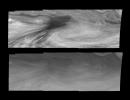
|
-
PIA01185:
-
Jupiter's Equatorial Region in the Near-Infrared and Violet (Time Set 2)
Full Resolution:
TIFF
(518.7 kB)
JPEG
(65.4 kB)
|

|
1998-03-06 |
Jupiter
|
Galileo
|
Solid-State Imaging
|
800x900x3 |

|
-
PIA01184:
-
A Jovian Hotspot in True and False Colors (Time set 3)
Full Resolution:
TIFF
(1.399 MB)
JPEG
(51.21 kB)
|

|
1998-03-06 |
Jupiter
|
Galileo
|
Solid-State Imaging
|
1300x1000x3 |
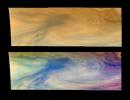
|
-
PIA01080:
-
A Jovian Hotspot in True and False Colors (Time set 1)
Full Resolution:
TIFF
(2.46 MB)
JPEG
(96.96 kB)
|

|
1998-03-06 |
Jupiter
|
Galileo
|
Solid-State Imaging
|
1300x1200x1 |
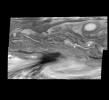
|
-
PIA00604:
-
Jupiter Equatorial Region
Full Resolution:
TIFF
(641.1 kB)
JPEG
(102.2 kB)
|

|
1998-03-06 |
Jupiter
|
Galileo
|
Solid-State Imaging
|
1300x1000x3 |
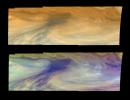
|
-
PIA00602:
-
E4 True and False Color Hot Spot Mosaic
Full Resolution:
TIFF
(2.378 MB)
JPEG
(86.53 kB)
|

|
1997-12-18 |
Jupiter
|
Galileo
|
Solid-State Imaging
|
518x368x3 |
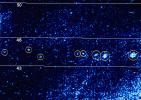
|
-
PIA01118:
-
Jovian Lightning
Full Resolution:
TIFF
(256.1 kB)
JPEG
(48.1 kB)
|

|
1997-12-18 |
Jupiter
|
Galileo
|
Solid-State Imaging
|
683x467x3 |
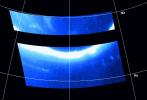
|
-
PIA01117:
-
Jupiter's Northern Auroral Oval
Full Resolution:
TIFF
(114.7 kB)
JPEG
(35.64 kB)
|

|
1997-12-18 |
Jupiter
|
Galileo
|
Solid-State Imaging
|
800x800x3 |
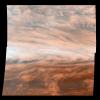
|
-
PIA00574:
-
"True" Color Mosaic of Jupiter's Belt-Zone Boundary
Full Resolution:
TIFF
(1.393 MB)
JPEG
(55.54 kB)
|

|
1997-12-18 |
Jupiter
|
Galileo
|
Solid-State Imaging
|
800x800x3 |
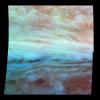
|
-
PIA01116:
-
False Color Mosaic of Jupiter's Belt-Zone Boundary
Full Resolution:
TIFF
(1.401 MB)
JPEG
(56.68 kB)
|

|
1997-12-18 |
Jupiter
|
Galileo
|
Solid-State Imaging
|
1000x1000x1 |
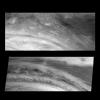
|
-
PIA01119:
-
Changes in Jupiter's Great Red Spot After Four Months
Full Resolution:
TIFF
(474.2 kB)
JPEG
(76.01 kB)
|

|
1997-12-18 |
Jupiter
|
Galileo
|
Solid-State Imaging
|
1000x1700x1 |

|
-
PIA01115:
-
Jupiter's Belt-Zone Boundary in Near-Infrared and Violet Light
Full Resolution:
TIFF
(748.1 kB)
JPEG
(103.3 kB)
|

|
1997-12-18 |
Jupiter
|
Galileo
|
Solid-State Imaging
|
1000x1700x1 |

|
-
PIA01114:
-
Using Methane Absorption to Probe Jupiter's Atmosphere
Full Resolution:
TIFF
(615.8 kB)
JPEG
(76.79 kB)
|

|
1997-12-18 |
Jupiter
|
Galileo
|
Solid-State Imaging
|
1000x1700x1 |

|
-
PIA01113:
-
Winds Near Jupiter's Belt-Zone Boundary
Full Resolution:
TIFF
(884.9 kB)
JPEG
(132.9 kB)
|

|
1997-12-18 |
Jupiter
|
Galileo
|
Solid-State Imaging
|
625x685x3 |

|
-
PIA00548:
-
False Color Mosaic of Jupiter's Belt-Zone Boundary
Full Resolution:
TIFF
(1.141 MB)
JPEG
(37.28 kB)
|

|
1997-12-18 |
Jupiter
|
Galileo
|
Solid-State Imaging
|
758x1028x1 |

|
-
PIA00560:
-
Aurora Borealis on Jupiter
Full Resolution:
TIFF
(400.7 kB)
JPEG
(80.66 kB)
|

|
1997-12-18 |
Jupiter
|
Galileo
|
Solid-State Imaging
|
820x1440x3 |

|
-
PIA00522:
-
Jupiter Stratospheric Haze Comparison
Full Resolution:
TIFF
(1.985 MB)
JPEG
(77 kB)
|

|
1997-12-10 |
Jupiter
|
Galileo
|
Solid-State Imaging
|
1650x950x3 |
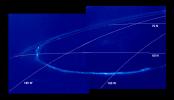
|
-
PIA01097:
-
Night Side Jovian Aurora
Full Resolution:
TIFF
(1.955 MB)
JPEG
(108.6 kB)
|

|
1997-12-10 |
Jupiter
|
Galileo
|
Solid-State Imaging
|
1700x900x3 |
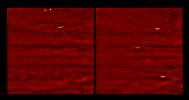
|
-
PIA01096:
-
Jovian Lightning and Moonlit Clouds
Full Resolution:
TIFF
(1.839 MB)
JPEG
(116.3 kB)
|

|
1997-12-04 |
Jupiter
|
Galileo
|
Solid-State Imaging
|
571x1000x3 |

|
-
PIA01093:
-
Turbulent Region Near Jupiter's Great Red Spot
Full Resolution:
TIFF
(2.077 MB)
JPEG
(76.4 kB)
|

|
1997-11-18 |
Jupiter
|
Galileo
|
Solid-State Imaging
|
1053x1491x3 |

|
-
PIA00600:
-
Family Portrait of Jupiter's Great Red Spot and the Galilean Satellites
Full Resolution:
TIFF
(2.21 MB)
JPEG
(112.7 kB)
|

|
1997-11-04 |
Jupiter
|
Galileo
|
Solid-State Imaging
|
313x256x1 |
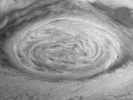
|
-
PIA01083:
-
Dynamics of Jupiter's Great Red Spot in the Near-infrared

Full Resolution:
|

|
1997-09-29 |
Jupiter
|
Galileo
|
Photopolarimeter Subsystem
|
875x605x3 |
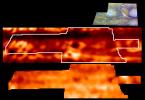
|
-
PIA00732:
-
Jupiter's Temperatures
Full Resolution:
TIFF
(771.1 kB)
JPEG
(49.91 kB)
|

|
1997-09-24 |
Jupiter
|
Galileo
|
Photopolarimeter Subsystem
|
585x376x3 |
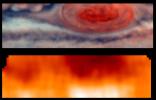
|
-
PIA00731:
-
Jovian Temperatures--Highest Resolution
Full Resolution:
TIFF
(447.1 kB)
JPEG
(17.9 kB)
|

|
1997-09-23 |
Jupiter
|
Galileo
|
Solid-State Imaging
|
614x900x1 |

|
-
PIA00605:
-
Visible Jovian Aurora
Full Resolution:
TIFF
(254.8 kB)
JPEG
(106.1 kB)
|

|
1997-09-23 |
Jupiter
|
Galileo
|
Solid-State Imaging
|
712x715x3 |
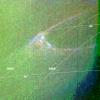
|
-
PIA00603:
-
False Color Aurora
Full Resolution:
TIFF
(1.705 MB)
JPEG
(98.67 kB)
|

|
1997-09-23 |
Jupiter
|
Galileo
|
Photopolarimeter Subsystem
|
807x700x3 |
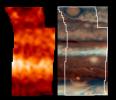
|
-
PIA00730:
-
Jupiter's Temperatures--Broad Latitude
Full Resolution:
TIFF
(1.011 MB)
JPEG
(42.99 kB)
|

|
1997-09-08 |
Jupiter
|
Galileo
|
Solid-State Imaging
|
700x800x3 |

|
-
PIA00506:
-
Thunderheads on Jupiter
Full Resolution:
TIFF
(1.007 MB)
JPEG
(63.96 kB)
|

|
1997-09-07 |
Jupiter
|
Galileo
|
Solid-State Imaging
|
513x701x1 |

|
-
PIA00724:
-
Mesoscale Waves in Jupiter's Atmosphere
Full Resolution:
TIFF
(109.9 kB)
JPEG
(28.37 kB)
|

|
1997-09-07 |
Jupiter
|
Galileo
|
Solid-State Imaging
|
550x750x1 |

|
-
PIA00725:
-
Time changes in Storm Clouds in Jupiter's Atmosphere
Full Resolution:
TIFF
(132.8 kB)
JPEG
(26.9 kB)
|

|
1997-09-07 |
Jupiter
|
Galileo
|
Solid-State Imaging
|
1000x1400x1 |

|
-
PIA00720:
-
Time Series of the Great Red Spot (near-infrared filter)
Full Resolution:
TIFF
(963.9 kB)
JPEG
(121.6 kB)
|

|
1997-09-07 |
Jupiter
|
Galileo
|
Solid-State Imaging
|
2800x1600x1 |
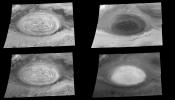
|
-
PIA00721:
-
The Great Red Spot at Four Different Wavelengths
Full Resolution:
TIFF
(2.567 MB)
JPEG
(311.5 kB)
|

|
1997-09-07 |
Jupiter
|
Galileo
|
Solid-State Imaging
|
1400x800x1 |
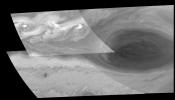
|
-
PIA00719:
-
New Territory West of the Great Red Spot
Full Resolution:
TIFF
(499.6 kB)
JPEG
(62.59 kB)
|

|
1997-09-07 |
Jupiter
|
Galileo
|
Solid-State Imaging
|
1546x1127x1 |
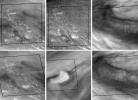
|
-
PIA00490:
-
Features of Jupiter's Great Red Spot
Full Resolution:
TIFF
(716.7 kB)
JPEG
(157.4 kB)
|

|
1997-09-07 |
Jupiter
|
Galileo
|
Solid-State Imaging
|
2100x1200x3 |
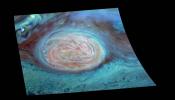
|
-
PIA00489:
-
False Color Mosaic Great Red Spot
Full Resolution:
TIFF
(4.767 MB)
JPEG
(167.5 kB)
|

|
1997-09-07 |
Jupiter
|
Galileo
|
Solid-State Imaging
|
2000x1431x3 |
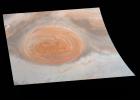
|
-
PIA00708:
-
True Color of Jupiter's Great Red Spot
Full Resolution:
TIFF
(3.943 MB)
JPEG
(108.4 kB)
|

|
1997-09-07 |
Jupiter
|
Galileo
|
Solid-State Imaging
|
1024x2048x3 |

|
-
PIA00296:
-
Jupiter's Great Red Spot
Full Resolution:
TIFF
(1.712 MB)
JPEG
(59.1 kB)
|

|
1997-09-07 |
Jupiter
|
Galileo
|
Solid-State Imaging
|
1400x900x1 |
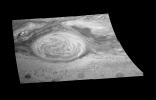
|
-
PIA00488:
-
Great Red Spot Mosaic - Near-infrared Filter
Full Resolution:
TIFF
(506.6 kB)
JPEG
(76.3 kB)
|

|
1996-01-29 |
Jupiter
|
Galileo
|
Solid-State Imaging
|
1600x1250x1 |
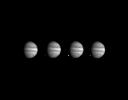
|
-
PIA00139:
-
Comet Shoemaker-Levy 9 Fragment W Impact With Jupiter
Full Resolution:
TIFF
(93.2 kB)
JPEG
(37.14 kB)
|

 Planetary Data System
Planetary Data System





















































